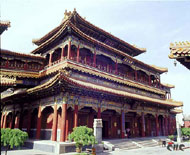 Situated on the east side of Yonghegong Street in the northeastern corner of the city, the Yonghe Lamasery is the largest and best-known lamasery in Beijing. The principal components are three exquisite memorial archways and five major halls, all of which stand on a north-south axis. The total area of the compound calculated from the southernmost memorial archway to the lamasery; s northernmost point is 66,400 square meters.
Situated on the east side of Yonghegong Street in the northeastern corner of the city, the Yonghe Lamasery is the largest and best-known lamasery in Beijing. The principal components are three exquisite memorial archways and five major halls, all of which stand on a north-south axis. The total area of the compound calculated from the southernmost memorial archway to the lamasery; s northernmost point is 66,400 square meters.
The Yonghe Lamasery was originally built by order of Emperor Kangxi in 1694 to serve as a residence for his son and successor to the throne-Yinzhen. The new residence was given the name the Mansion of the Beile Yin. When his title was later officially raised to that of prince, the name of the residence was changed to?Residence of Prince Yong.?Yinzhen lived here till his ascension to the throne in1723.
When Yinzhen became Emperor Yongzheng after his father?s death, a section of the residential grounds was maintained as a temporary palace to be used by the emperor for short visits, while the other half was turned over tot eh Lamaists to serve as a place for the recitation of scriptures. Later, the palace section was razed by fire and in 1725 that section of the compound occupied by the Lamas was given the name Yonghe (Harmony and Peace) Lamasery.
Entering the lamasery compound at eh southernmost gate, the visitor will notice that this first courtyard contains only two screen walls decorated with carved murals and a single memorial archway. To the north through the gateway, a stone-paved pathway leads through the center of a rectangular courtyard planted with pines and cypresses to the Gate of Luminary Peace (Zhaotaimen).
This gate leads into the third courtyard, where two stela pavilions and the Drum and Bell towers typical of all Buddhist temples may be seen. At the north end of this courtyard stands the Gate of Harmony and Peace (Yonghemen), the entrance to the Devaraja Hall (Tianwangdian). In the center of the hall is a statue of Maitreya Buddha and, flanking it, four large statues of the Heavenly Kings.
Behind this hall is a stela pavilion containing a tall stone tablet inscribed in the han (Chinese), Manchu, Mongolian and Tibetan languages. A bypass from here leads to the largest hall in the lamasery-the Hall of Harmony and Peace.
The hall?s pillars and square ceiling panels are painted in brilliant varicolored motifs. In the center is an altar where offerings are made to the Buddhas of the Three Ages-Sakyamuni, Kasyapa and Maitreya. On the side walls are mural paintings of the 18 arhats, and in the corners images of Ksitigarbha and Maitreya.
The entrance to the fifth courtyard is known as the Hall of Eternal Blessings (Yongyoudian). This hall and the Hall of Heavenly Kings are almost identical in size. Immediately to the north is the Hall of the Dharmacackra (Wheel of the Dharma) in which stands a 15-meter-high bronze statue of the founder of the Yellow Sect of Tibetan Buddhism, Tsong-kha-pa. Behind the statue is a panoramic sandalwood sculpture of 500 arhats standing indifferent postures on a hill, known as the hill of the Arhats. On the walls there are huge mural paintings depicting episodes in the life of the Buddha.
The principal building in the rearmost courtyard and tallest building in the lamasery is the three-story Hall of Infinite Happiness (Wangfuge), also called the Hall of Great Buddha (Dafolou). Flanking it on both sides is two two-story pavilions-the Eternal Health Pavilion (Yongkangge) and the Perpetual Tranquility Pavilion (Yanningge), both connected to the central hall by overhead bridges. A huge statue of the Tathagata Buddha (Rulaifo) stands in the center of the hall. Made from the trunk of a single sandalwood tree, the standing statue is 26 meters in height (eight meters below the ground floor and 18 meters above) and eight meters in diameter. It is said that when this statue was first installed it was fitted with a yellow monk?s robe made of more than 1,800 meters of satin.
Besides the structures described above, the Yonghe lamasery has a number of auxiliary buildings lining the courtyards on the east and west, many of which display exotic Lamaist sculptures and paintings. The buildings set along the central axis rise progressively from south to north, and a visitor entering from the southernmost gate looking north will see a series of roof-ridges rising impressively one above the next.
The lamaseries house a treasury of Buddhist art. To mention a few of the most interesting items: examples of the calligraphy of Qing emperors written on scrolls and inscribed on stelae; bronze lions and incense burners; sculptured images of gods, demons and Buddhas; and Tibetan-style murals.












